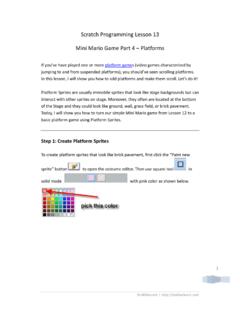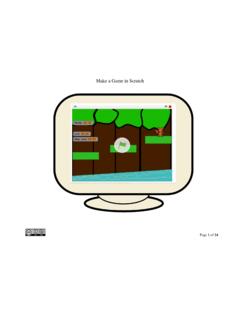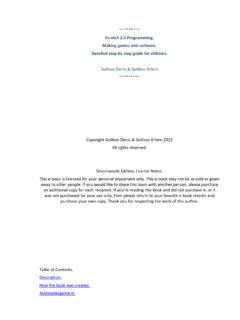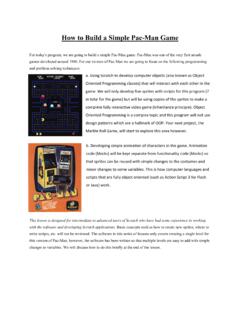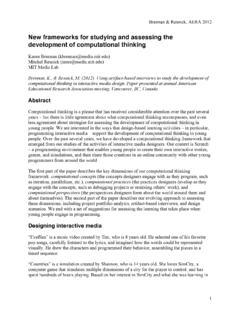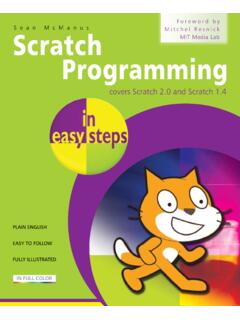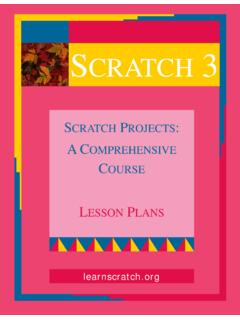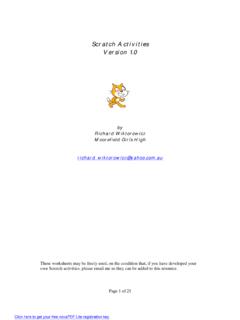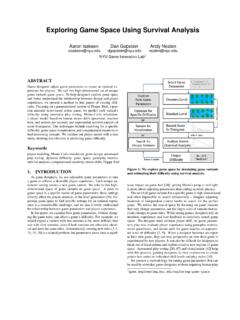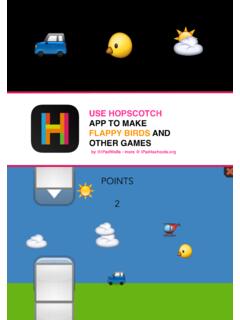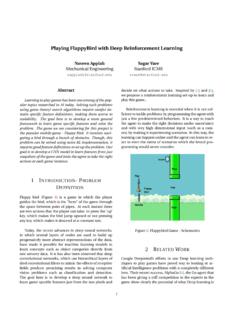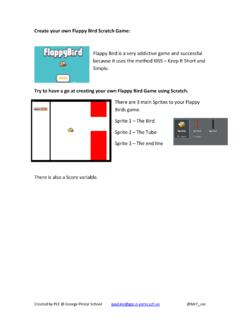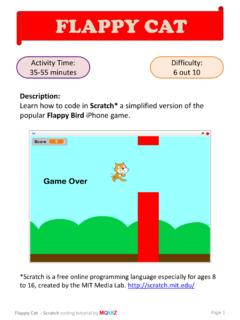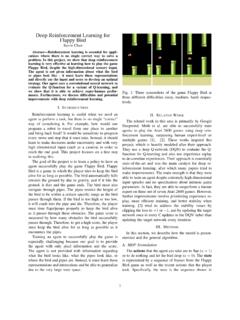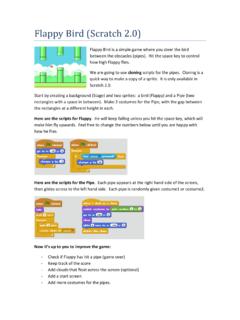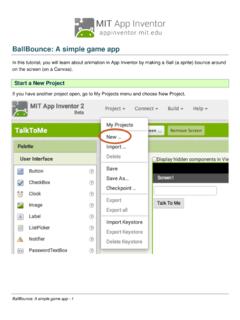Transcription of Scripts - ScratchEd
1 How to Build A Shooter Game using SCRATCH (Advanced) In these lessons I will show you how to build a basic shooter game using the SCRATCH programming language. The pur-pose of these lessons is to show you how to program a game and not how to make the coolest looking or most interesting game (that s up to you). This is an advanced lesson and assumes you are familiar and comfortable with SCRATCH and pro-gramming concepts. How the Game Works When the green flag is clicked enemies (in my game basketballs) randomly fall from the sky. A variation you could easily add would be enemy ships running patterns in random order. You control a base ship that moves back and forth with the arrow keys on the bottom and uses the space bar to fire a laser.
2 If the laser hits the enemies you score a point. If the enemies fall on you before you shoot them you loose a life. If you loose three lives the game is over. There are sounds when you fire your laser or are hit by an enemy ship. So with that let s get started. Getting Started The first thing you will need to do is to create four sprites for your game and name them Ship, Laser, Enemy 1 and Game Over . You may choose different names for your char-acters but you will need to make some changes to these instructions if you do. We will start by getting our ship moving across the screen side to side and setting it up to fire the laser. In the ship s script area, select four top hat blocks from the Control block three that allow you to assign keys and one that allows you to change things when the flag is clicked.
3 Now from the Motion Block select a Move 10 Steps block and attach it to a key control block and set the key control block to a right arrow key. This will allow you to move your ship right with the right arrow key. Now from the Motion Block select another Move 10 Steps block and attach it to a key control block and set it to a left arrow key. Now change the value in this Move 10 Steps block to 10. This will allow your ship to move left with the left arrow key (as you take away 10 spaces). Place your ship at the bottom of the stage and test your program by tapping on the arrow key s. Your ship should move right and left. Setting up the Laser With the laser we need to tell our program when to fire, where to position the laser when it is fired and how to move (later we will tell it what to do if it hits an enemy).
4 Select the Laser sprite and then the Scripts tab for this Sprite. Select the Control block and build a new broadcast message called fire. Then build the blocks you see in the diagram that s to your left. Here is how this works. Later, we will attach a send fire message to the ships space bar key. When the space bar is pressed, the laser sprite gets the message and uses the Motion Block called go to Ship to center itself with the ship. It then use the (Looks Block) show to make sure it is visible on the screen. A forever (Control block ) starts a loop where y is changed by 10 (added) each time through the loop making the laser beam go up the screen. In the middle of the loop we check to see IF the lasers Y position is greater than 190 (the top of the screen).
5 If it is, we hide the laser character (as it is now off the screen) and stop the script until it is called again by the user pressing the spacebar. When the user pressed the space bar again this whole process is repeated. The Enemy Ship Before writing the software for the enemy ship there are a few things we want to set-up. First, we want to create three Vari-ables called HitShip?, position and score . HitShip? will be used (later) to decide if our ship was hit by the enemy. Position will be used to randomly select a position for the enemy ship to fall from and score will be used to keep track of our games score. We will also tick the score variable so it appears on the stage to show our score.
6 You can position the score on the stage. We will also create 6 costumes for our enemy player. Costume 1 is the regular costume for our player and costumes 2 6 are used to animate the enemy player being hit by the laser. If you want you can also skip this step and simply use a hide block with the enemy when it is hit. In my opinion the animation is nicer and is usually part of video games . Writing the In the Scripts panel for Enemy 1 you are going to build the blocks you see in the diagram that s to your left. Here is how this works. Select the Con-trol block and build a new broadcast message called newball1. When this broadcast is received (from the green flag) it will start a new enemy fal-ling from the top.
7 A random number is selected be-tween 226 and 222 (the width of the top) and given to the position variable. The enemy s X (width) is then set to this and Y is set to 188 (so the ball is at the top out of sight). The costume is set to its regular costume1 and the enemy is shown on the screen. A forever loop starts to run and will move the enemy down the screen by 10 with a slight pause so it is not too fast. As the loop runs it will check IF certain things happen each time through the loop. The first things it checks is to see IF the laser is touching the enemy. If this is true then it plays a sound, adds 1 to the score, broad casts a mes-sage called hit (that makes the laser disappear) and goes through the costumes to make the ball look like it exploded and hides it at the end.
8 The loop then checks to see IF the enemy ship has hit our ship. If it has, then it adds 1 to the variable HitShip?(takes away one of our lives), broadcasts a ShipHit message and hides the enemy. At the end of the loop if checks to see IF its Y position equals 180 (The bottom of the screen). If this is true it then hides the enemy ship waits for 3 seconds and broadcasts a message to itself (newball1) to tell it to start itself over again. Something giving itself an instruction to do something is a programming concept called recursion and is very common in video game development. Finishing Our Ship Before we finish our ship s software we will create 4 costumes for our ship.
9 Costume 1 is the regular costume for our ship and costumes 2 4 are used show when our ship has been hit by an enemy player and how many lives are left. In the Scripts panel for Ship you are going to build the blocks you see in the dia-gram that s to your left. The arrow key were discussed earlier and there are no changes. We will start by hooking up a fire broadcast to our space bar. This sends a message to the laser block and sets it going. We also added a sound once we have sent the fire broadcast (I ll cover the IF Hit-Ship? = 4 later) For the green flag block(Start Game) we will have it set HitShip? to 0 meaning none of our ships have been hit by the enemy (again I ll cover HitShip?)
10 Later) show our ship, and makes sure its set to costume1 meaning our ship has not been hit yet. Remembering back to our Enemy1, one of the things it did was if it ran into our ship (without being destroyed first) it sent a broadcast called ShipHit and added 1 to a vari-able called HitShip?. We will now use this with our Ship. Here is how it works. When a ShipHit message is received by out ship it plays a collision sound and checks the value of the HitShip? variable. Depending on the value of HitShip? It adjust the cos-tume of our ship. On the fourth time our ship has been hit (HitShip? = 4 )it hides our ship and broadcasts a message called Game Over.
